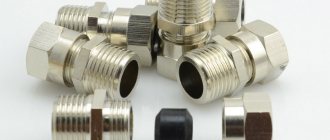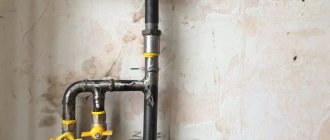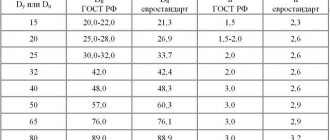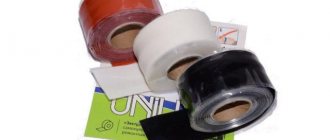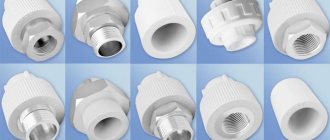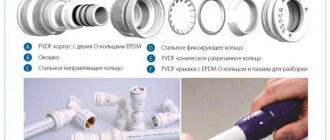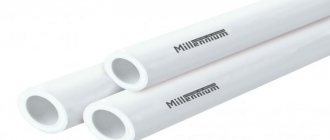Although the first threaded connections appeared more than three hundred years ago, humanity could not find a universal and 100% working way to seal them for a long time. The invention of the so-called FUM tape, although not completely, helped solve this problem. Today, the plumbing market offers two main types of this material, intended for gas or water pipes. In this article we will look at their features, similarities and differences, and determine whether they are interchangeable.
Fum Tape for Gas and Water Differences
Polypropylene pipes and fittings, the price of which is the most favorable in comparison with analogues from other materials, are today widely used in the construction of hot and cold water supply systems due to the many advantages of polypropylene. Polypropylene pipes are stronger, lighter than steel, not subject to chemical and electrical corrosion, do not rust or clog during operation, and do not conduct stray currents. The pipes are resistant to acids and alkalis, as well as most known aggressive and toxic liquids and gases. The pipes do not require painting, are easy to install, and are connected in a few seconds using a welding machine.
The pipes are environmentally friendly and are successfully used in pipelines for cold and hot water supply, heating and as process pipelines with a working pressure of up to 25 atm. If you are interested in purchasing sewer pipes, polypropylene products are also excellent. Thanks to fittings with chrome-plated brass inserts with inch threads, the pipes easily connect to existing steel plumbing fixtures.
When choosing products such as polypropylene pipes and fittings, price is not at all the main factor in saving. Thus, the economic effect of using polypropylene pipes instead of steel ones consists of saving operating costs, reducing labor intensity and waste during installation, as well as a significant service life of more than 50 years. The present cost of pipelines made of polypropylene is 30-40% lower than the cost of pipelines made of galvanized steel or cast iron pipes.
This catalog contains prices for polypropylene pipes and fittings, information about the properties, range and methods of installation of pressure pipelines made of high molecular weight static copolymer propylene - ethylene with low melt fluidity (PP-R material). The PP-R material is characterized by increased heat resistance, good resistance to aqueous solutions of salts and inorganic acids that do not have oxidizing properties, as well as to alkalis, organic acids, alcohols or ethers.
Polypropylene is an isotactic thermoplastic, first produced in 1954.
Polypropylene is produced by polymerization of propylene gas, which has the chemical formula: CH2CHCH3.
Polypropylene has the following modifications:
- propylene homopolymer (type 1) PPH;
- copolymers of propylene and ethylene (type 2) PPV - block copolymer;
- static copolymer of propylene with ethylene (type 3) random copolymer - originally designated as liliRC - polypropylene random copolymer.
Pipes and fittings for POLITEK water supply are made from the 3rd type of polypropylene - random copolymer.
www.ilma.spb.ru
Gas pipes can be metal or plastic. During their installation, special attention should be paid to sealing pipe connections. The sealing of gas pipes must be done especially carefully. If you use sealants that are not intended for these purposes, then in the future you may encounter gas leaks, which can lead to an explosion. Threaded connections are sealed using sealants and sealants.
Solvent based sealants
This sealant for gas pipes is a drying paste. Often a solvent based sealer is used in conjunction with flax. Before connecting the pipes, the threads are coated with sealant. After a certain time, the composition hardens in the threaded gap and prevents gas leaks. Such sealants have one serious drawback - if you need to fix a large thread gap, you should keep in mind that in this case the sealant will shrink. Also, such joints need regular tightening.
Linen winding
Winding for gas pipes is used for sealing pipes together with red lead on drying oil. You can replace red lead with iron. If you use only linen winding during pipe installation, the risk of corrosion of threaded connections in this case will increase. Linen winding is quite inexpensive and provides high fixation strength and adhesion. Sealing pipes using winding is carried out as follows:
1. Several notches can be applied to the outside of the thread. Thanks to the notches, the winding will not slip. The notches are applied to the thread using a file.
2. Then you need to extract several fibers from the flax tow and twist them into a thin rope.
3. This linen rope is wound around the thread, starting from its edge.
Winding must be done in the opposite direction from the direction of the thread.
4. As soon as all the recesses of the thread are filled, red lead on drying oil is applied on top of the winding.
5. Then the connection must be carefully tightened, smoothing out the protruding flax fibers.
Using FUM tape for sealing pipes
FUM tape is a fairly thin fluoroplastic film. This film provides ease of tightening and chemical resistance of the connection. FUM tape has serious disadvantages:
— low quality of sealing of those connections that are subject to vibration; — insufficiently high quality of sealing of threaded connections exceeding ¾ inch in diameter.
FUM tape should be wound onto a clean and dry joint, like linen thread.
Universal sealing thread
If you are looking for another way to wrap up a gas pipe, try nylon tape. The following universal sealing tapes can be found on sale: “Record”, “Unilok” and “Locktain 55”. The advantages of nylon tape are as follows:
— affordable cost; — ease of use; — high quality sealing of gas pipes; - high connection strength.
Before winding the universal sealing tape onto the threads, be sure to make notches on it. Also, this sealing tape is not recommended for sealing large diameter gas pipes.
truba-info.ru
FUM analogues, which is better: flax, tape or liquid sealants
Due to the complex installation technology, many inexperienced craftsmen try to choose an alternative option so as not to use fum tape. The following materials are used as seals at pipe joints:
- tow;
- universal thread;
- liquid FUM (anaerobic sealants).
Each type of material has its own characteristics, advantages and disadvantages, as well as recommended areas of application. Therefore, craftsmen are often concerned about what is better to choose: tow or fum tape, liquid sealant or another option.
In addition to fum tape, there are other materials for sealing threaded connections
Important! Under the influence of ultraviolet radiation, the service life of fluoroplastic products is significantly reduced. Therefore, it is advisable to store reels of tape away from sunlight, in a dry place. Air humidity should not exceed 80%. It is not allowed to store the tape near heating devices, the minimum distance is 1 m.
Should I replace the tape with tow: what is winding and why is it good?
Tow is a natural material based on flax fibers. Designed for sealing steel pipes. It is considered a traditional winding for plumbing systems and, despite the extensive range of more modern materials, is still in high demand among craftsmen.
To determine what is better to take for work: fum tape or flax, it is worth comparing the advantages and disadvantages of these materials. Advantages of sanitary tow:
- the connection is easily adjustable, the fitting can be unscrewed by 45°;
- the material is resistant to mechanical loads;
- high degree of sealing;
- winding over wet or dirty threads is possible;
- due to its ability to absorb moisture, tow swells and blocks minor leaks;
- if necessary, the material can be easily dismantled.
In some cases it is more convenient to use tow
The disadvantages of tow include its susceptibility to rotting. When exposed to moisture, this natural material slowly decomposes.
The scope of application largely depends on what the tow is made from. Plumbing combed flax consists of long, thin fibers that have high strength. They fit tightly and well into the thread. When connecting elements by screwing, the material is not destroyed, so combed flax is best used for gas and pipeline systems.
Torn flax acts as a raw material for the production of combed flax. This material is coarser and its fibers are clogged. It is suitable for sealing threaded connections in water supply systems. Usually tow is preferred by people who do not know how to use fum tape.
In some cases, it is more appropriate to use tape:
- installation of small diameter pipes;
- sealing thin-walled fittings;
- working with plastic pipes.
Thus, to connect a flexible hose to a kitchen faucet, tape is more suitable, and to create a tight connection between a water pipe and a fitting, it is better to use tow.
Helpful advice! It is preferable to use tow when installing pipes with a large diameter. Manufacturers make notches on the threads specifically for this material.
Tow is as easy to wind as fum tape
Characteristics and scope of application of liquid FUM
Liquid FUM consists of methacrylic anaerobic resin. This product cures slowly to securely lock threaded metal connections. It is not afraid of vibrations, remains flexible and is resistant to temperature changes. Unlike tape, sealant perfectly withstands multidirectional loads and fills voids and small gaps well.
Liquid FUM can fully replace tape and tow in systems with different fillings:
- cold and hot water;
- diesel fuel;
- various oils;
- gas (except oxygen);
- almost any chemical compound.
Externally, anaerobic sealant looks like a blue liquid with a viscous consistency. The density of this product is 1.09 g/cm³. There is a slight odor. General characteristics:
- operating temperature - from -55°C to 180°C;
- shelf life - more than 12 months. (at a temperature not exceeding 28°C);
- withstands pressure up to 50 bar;
- afraid of solvents - trichloroethane, acetone.
The use of anaerobic thread sealant in plumbing work
Primary hardening of the material occurs after 2-3 hours; complete hardening requires from 12 to 24 hours.
Note! When oxides or metal particles enter the sealant, an exothermic reaction is triggered - heat is released.
Fum tape: what is it ↑
Plumbing tape: production and types ↑
PTFE sealing material, or fum tape for short, is a polytetrafluoroethylene film used to seal pipe joints. It is made by rolling out a fluoroplastic rope to the required thickness. The sealant is produced in the form of a tape of a certain size, wound on a reel (similar to electrical tape). Used when installing systems under pressure: water supply, gas supply, central heating. The material functions as a deformable filler and at the same time as a thread lubricant, which improves the sealing of connections.
Types of fum tape:
- fum-1 – designed for sealing pipelines working with aggressive media. Contains lubricant – purified petroleum jelly;
- fum-2 - used in systems in contact with strong oxidizing agents, therefore it is not impregnated with lubricant;
- fum-3 - used in systems working with clean media. Does not contain lubricant.
Plumbing tape fum also varies in size: thickness ranges from 0.075 to 0.25 mm; width starts from 10 mm; length from 1000 mm.
They produce a special yellow gas fum tape with a thickness of 0.15-0.25 mm. For gas pipes operating under low pressure, the use of ordinary plumbing tape is allowed.
Technical characteristics and properties of fum tape ↑
Main properties of PTFE:
- Low coefficient of friction. Fluorinated plastic polymers (PTFE) have a very low coefficient of friction - they are slippery, which makes it easier to connect fittings. They act as a kind of gasket for pipe threads, improving fit and sealing.
- Heat resistance. PTFE has an extremely high melting point for a plastic - 327 degrees. They are designed for use at temperatures up to 260 degrees (when heated above, they release toxic fluoride compounds). PTFE is an excellent dielectric (electrical insulator), which is an added benefit.
- Plasticity and strength. Resistant to mechanical stress. They operate at a constant pressure of up to 10 MPa and withstand differences of up to 41 MPa. Average service life is 13 years. Prolonged exposure to light slightly degrades properties.
- Chemical and biological inertness. They are highly resistant to acids and alkalis. There is no solvent for PTFE yet. The polymers are uniformly coated with fluorine atoms, which makes the material inert to almost all chemicals. Decomposition is possible only under extreme conditions created in special laboratories. Not subject to rotting.
Classification of fum tape: how to choose the right material for various jobs
When installing pipes, the tape performs several functions at once. It is used as a deformable filler and also replaces thread lubricant, making the connections absolutely tight.
Within the framework of the general classification, the following brands are distinguished:
- Fum-1 - designed for systems with aggressive environments. The products are coated with lubricant. To process Fum-1 tape, manufacturers usually use petroleum jelly (purified).
- Fum-2 - used in pipelines where contact with strong oxidizing agents, such as oxygen, is possible. Manufacturers do not impregnate with Vaseline.
- Fum-3 - designed for systems with a clean environment. There is no lubricant on the products.
When installing pipeline systems for domestic use, experts recommend using the Fum-1 brand. It has all the necessary characteristics for operation in such conditions. Sometimes Fum-3 tape is used for these purposes. The thickness of this brand is 0.12 mm, width - from 3 to 25 mm.
Technical characteristics of fum tape:
| Characteristic | Brand 1 | Brand 2 |
| Lubricant quantity | 20% | 0,3% |
| Material width | From 1 to 6 cm | From 5 mm to 6 cm |
| Material thickness | 0.1 to 1.4 mm | From 0.035 to 0.2 mm |
| Stress limit (if the material is stretched) | 40 kg/cm² | 60 kg/cm² |
| Ultimate tensile breaking load (elongation before breaking) | From 100 to 200% | 100% |
Size and features of selection of sanitary fum tape
Depending on the manufacturer, the width of the products varies between 10-60 mm. The most commonly found tapes on sale are the following thicknesses: 0.075 and 0.12 mm, 0.1 and 0.2 mm. The minimum length of a skein is 2 m. For each type of work, the tape is selected individually. In this case, not only the diameter of the thread matters, but also the degree of experience of the master himself.
The tape used in plumbing has the following characteristics:
- capable of operating at temperatures of -70°C (cold water supply) and 200-250°C (hot water pipes);
- Provides corrosion protection, preventing thread damage;
- can withstand pressure equal to 100 atmospheres.
According to the characteristics declared by the manufacturers and the test results, the plumbing tape performs excellently during operation. However, if there is a lack of experience, this type of seal is more likely to leak than others.
Important! When purchasing a product, you must pay attention to such an indicator as breaking load. The tape must stretch well. If the material is of low quality, it will tear even with little force.
Fum tape can withstand operating temperatures up to 250 degrees
Despite the fact that the price of fum tape for water is affordable (minimum - 10-15 rubles, from well-known and reliable companies - from 100 to 170 rubles), this material itself has a high consumption. Especially if a person takes on this work for the first time. A beginner who does not know how to wind fum tape correctly will have to practice threading several times and try out different types of products before he can choose the right option and achieve the desired result.
Specificity and characteristics of fum tape for gas
Manufacturers produce a special fluoroplastic sealant for gas systems. It also has the form of a tape and is designed for pipelines made of various materials. This type of sealant performs well in aggressive environments and general industrial systems. It is yellow in color, so it cannot be confused with another material.
The tape itself is made of fluoroplastic film (not sintered). The width of the products is 1.2 cm. The thickness of the film is from 0.1 to 0.25 mm. It goes on sale in skeins 10 m long. This type of material can be used to seal joints of plumbing and heating systems. It retains its strength and technical characteristics over a wide temperature range. Quite inert and versatile.
The tape, designed for gas systems, is easy to use. It prevents “souring” of the joints, which greatly facilitates the dismantling of elements if repairs are necessary.
Gas tape is available in yellow color
General characteristics of gas fum tape:
- manufacturing material – polytetrafluoroethylene;
- the density of the material is 1.2 g/cm³;
- operating temperature - from -200°C to 260°C;
- Suitable for low pressure systems only.
In practice, it turns out that the tape is not capable of providing strong connections. Its capabilities are only sufficient to combine short pipes. In this case, additional fasteners must be installed at the joints, which will protect the joint from bends and fractures.
Important! Household gas is very dangerous, so it is not recommended to repair the system yourself. To do this, it is better to call a specialist.
Differences between fum tape for gas and water
Both products are made from fluoroplastic-4, so the tapes have the same thread structure, as well as similar skein dimensions (length and width). According to GOST, the thickness of the seal for gas and water is similar - within 0.1-0.2 mm.
Related article:
Bellows gas connection: the safest way to connect gas equipment
Features of application, advantages and disadvantages. Other types of flexible hoses for connecting gas equipment. Safety precautions.
Main differences:
- Price - gas pipe tape costs a little more.
- Color - Plumbing products come in white and translucent, while gas products only come in yellow.
- Density - the material for gas systems is much denser than conventional tape.
- Quality requirements - the gas tape must have an appropriate certificate.
Different colors of the tape indicate the material with which you can work: gas - yellow, stainless steel - gray, plumbing - pink, oxygen - green
Since the gas is explosive and can cause serious harm to human health, increased demands are placed on the sealing material. It is not enough to simply purchase a tape with the appropriate marking on the package, because many manufacturers are cunning. According to paragraph 10-221 of building regulations 42.101-2003, the quality of the tape, as well as its performance characteristics, must be confirmed by a certificate. Only in this case can you be confident in the safety and reliability of future connections.
Some sources and user reviews claim that a regular Fum-2 seal can be used in gas systems (provided the material is of high quality). In fact, in such cases, you should not use plumber's tape. Gas has low density. Even with a strong connection with high-quality sealing, it can leak out. That is why gas tape is made of a denser material than tap tape, and the bright yellow color allows you to distinguish them.
Tow: what is it and how to work with it ↑
Before fum tape appeared on the market, plumbing tow, which was flax fibers, was used to seal threaded connections of pipes. Optimal results were achieved by coating the layer of tow wound on the thread with a small amount of oil paint. Such a connection was difficult to disassemble after several years.
Now sanitary linen in the form of long silky threads is used along with new sealing materials. Only now a layer of sealing paste is applied on top of the winding, ensuring a reliable and durable connection. The paste protects the flax from rotting and makes dismantling easier if necessary.
IS IT NOT BETTER TO USE TOCHOW?
Tow began to be used by plumbers long before the advent of newer sealing materials. This is precisely what the age-old question is connected with: linen or fum tape, which is better? And although the first option has been tested by generations of installers, it has a significant drawback - you will need skills to work with tow correctly. Fum materials do not require special skills.
Each flax fiber must be separated and straightened. Once laid, the threads cannot intersect. And the amount of tow must be correctly determined; both an excess and a lack of it will lead to the fact that the joint will begin to “tear.” It’s also worth remembering about the layer of sealant that will have to be applied on top with a brush. In general, it’s not for nothing that many have switched to fum!
If you still don’t understand how to wind fum tape, the video instructions will definitely help you understand this issue. Happy installation!
FUM tape is a thin sealing material that has good strength properties, resistance to aggressive chemical environments and heat resistance. Thanks to these qualities, this material is widely used for domestic purposes as a sealant for water pipes and gas systems. In this article we will tell you step by step how to properly wind on a thread.
.
How to wind tow on a thread ↑
To prevent the flax from sliding along the thread, there are notches on it.
Please note: if there are no factory notches, they must be applied yourself, otherwise when screwing on the fitting, the flax will run off the thread.
For winding, a small strand of flax is separated. The length and thickness of the “strand” are determined visually depending on the diameter of the pipe. The winding is done as tightly as possible, the threads are directed along the thread, the free end of the tow is fixed with a finger, and after a couple of turns it is brought into the guide strand. The tightness of the connection is ensured by the optimal layer thickness. It is quite difficult to calculate the density: you need experience and a certain “plumbing” eye.
A simple way to wind a fumka onto a threaded connection
Often, before laying the seal, craftsmen degrease and dry the threads. This is of course useful, but for the fumigator the presence of traces of lubricant is not of fundamental importance. The main thing is to clean the grooves from debris, dust and small steel shavings remaining after cutting the thread.
For winding, two rules are used:
- The direction of laying the fusel should coincide with the rotation of the nut or coupling when screwing onto the thread;
- Fum tape is laid from the base of the thread to its exit at the end of the pipe.
The fumka must be straightened into an even strip, without kinks or folds, and laid with slight tension so that the turns stick to each other, but the material does not delaminate and is not cut at the sharp tops of the thread. Depending on the size of the connection, the fluoroplastic sheet can fill from ½ to ¾ of the thread depth.
There is no need to try to squeeze the fluoroplastic cocoon with your hand in order to settle and compact the material; usually this does not work. If the cut strip turns out to be too long, you need to unwind a few centimeters, cut off the excess and carefully place the edge of the tape on the winding layer. In a situation where there is too little investment material and the coupling is wrapped along the thread without any effort, you need to cut off the winding without regret and completely replace it with a correctly measured new piece. No winding of additional pieces is allowed.
Advice! To make it easier to screw a nut or coupling onto a thread packed in fluoroplastic, the last turn is left without a winding. This allows you to avoid distortions and cuts of the investment material.
How to properly wind fum tape onto a thread ↑
The tape is wound around the external thread of the fitting. When repairing plumbing, the old connection must be cleaned of rust and dirt, and then the surface must be degreased with a solvent. Winding is done only after drying. The main requirement: the fum tape should be pulled quite tightly so that it fills the grooves and fits the thread tightly. Experienced plumbers say that it is better for the tape to break than for loose winding. The number of layers varies from 4–6 to 20–25 and depends on the thickness, width of the tape and pipe diameter - the main thing is that all the threads are hidden. Plumbing tape requires a little more than tow, since, unlike flax, it will shrink. When working with fittings with a diameter of 1 inch or more, it is more convenient to wind the fuse over the entire width, making sure that it is pressed into the coils. After screwing the nut, the fibers of the fum tape are torn into threads that fill the interturn space - the seal remains in the thread and seals it.
Important: adjustment (adjustment) without loss of tightness is impossible - you cannot even slightly unscrew a twisted fitting.
Winding tape onto pipe threads
This operation is always performed using an external thread. If repairs are made by replacing the fitting, the pipe threads must be thoroughly cleaned of dirt and rust, degreased using acetone or white spirit, and dried in air for about 10 - 12 minutes. How to use a pipe burner to ensure its effectiveness:
- the seal must be wound onto the thread from its rear end;
- the FUM tape is applied in the direction of its descent, that is, its end should be located in the direction of screwing on the fitting;
- winding is carried out with tension, ensuring a tight fit of the pipe thread profile; it is better to allow the tape to break than to perform loose winding;
Important! The threads are notched in the axial direction to prevent rotation of the sealing material when screwing on the fitting.
If there are no such notches, you need to do them yourself.
FUM tape for pipes is a modern and most commonly used means for sealing joints in pipelines for various purposes. FUM cord products that have appeared in recent years do not provide any special advantages either in application technology or in efficiency.
To understand how to use FUM tape for gas pipes, you need to take into account the characteristics of the material and apply it in the appropriate way.
Watch the video
Alternative materials – linen tow
Various seals are used, which include bast fibers in the form of strands and various sealants.
One of the first sealing materials to find widespread use in pipeline installation is tow. This is still the name given to flax fibers in the form of strands wound on the external thread of a pipe.
In this case, it is important to wind it carefully in turns, filling out the full cutting profile. For more reliable sealing, the winding of tow is covered with additional materials, from thickly rubbed paint to specially developed sealants.
We have already noted that with fairly high efficiency, connections using paint become practically permanent, and pipeline systems are of little use for repair.
Which is better: tow or fum tape ↑
Each material has its own advantages and disadvantages. Plumbing flax is used to seal joints of steel pipes (especially rusty and/or large diameter ones).
Advantages of tow:
- the ability to adjust the connection: unscrewing back by 45 degrees is permissible;
- reliable tightness: absorbs moisture well;
- resistance to mechanical stress;
- easy dismantling of the connection.
The disadvantage is the tendency to rot/decompose, since tow is a natural material.
It is preferable to use plumbing tape on small-diameter pipes, plastic pipes, and in the case of thin-walled fittings. It is easier to work with fum tape and takes less time to install.
There is no clear answer to the question: “Which is better – fum tape or sanitary linen?” It all depends on the specific plumbing job. For example, it is more convenient to connect a kitchen faucet with a flexible hose using fum tape, and it is better to seal a fitting on a water pipe using tow.
Polymer competitors of fum materials
The difficulty of handling fum tape forces amateurs to use more radical packaging methods. For example, use anaerobic sealants, Unitec-type adhesives, automotive silicone repair kits and even epoxy materials.
Gluing metal and metal-plastic pipes will only be correct if there is gas or high-pressure steam in the pipeline. In this situation, the life and health of homeowners depends on the strength of the connection. In other cases, it makes no sense to buy a 75 ml tube of glue for 800-1000 rubles to assemble one or two joints. It’s easier and cheaper to buy linen for 30 rubles or use high-quality fum tape. When used correctly, it is enough to pack a dozen compounds.
Anaerobic gel sealants: sanitary gel ↑
Another modern material for sealing pipe threads is sanitary gel. Reliable compaction occurs due to the polymer component of the gel. After hardening, sanitary gel does not shrink or expand, is resistant to temperature changes (from -60 to +150) and pressure surges, and has proven itself in various environments: water, natural and liquefied gas, heating antifreeze.
Sanitary gel is produced in three types:
- In green tubes - easy dismantling.
- In blue - medium dismantling.
- In red (Stop Master Gel) – dismantling with heating.
Installation using sanitary gel is simple: shake the tube and apply the gel in a thick layer around the entire circumference of the thread, distribute it evenly (with a brush, a special spatula), and assemble the structure. Excess gel is removed with a rag. Polymerization of the gel occurs in 15–20 minutes.
Important: Sanitary gel should only be applied to a clean, grease-free surface.
hydroguide.ru
What is fum tape
FUM tape is a sealant, which is a narrow thin unsintered film made of fluoroplastic. The abbreviation “FUM” stands for: fluoroplastic sealing material.
All manufacturers of this sanitary film offer two types: white (thick) and translucent (thin). Both of these materials have a similar list of characteristics. Namely:
- are characterized by heat resistance;
- elastic;
- resistant to chemicals;
- average tensile strength 1.5 MPa;
- elongation at break not less than 200%;
- thickness 0.075-0.2 mm.
The film is made by rolling a fluoroplastic rope and wound onto polypropylene reels equipped with a lid. The width of the tape can be different: from 10 to 60 mm. To prevent the thin elastic film from sticking together during winding, one side of the tape is coated with lubricant. Most often this is medical Vaseline oil. There are also sealing films without lubricant.
Types of fum tape
There are three types of sanitary fum tape. Each brand is intended for use at sites with different work requirements. The numbers indicate the grade of the product. 1 – first grade, 2 – second grade, etc.
- Brand "FUM-1". Designed to perform plumbing work on utility lines for domestic and industrial purposes. Resistant to aggressive environments, heat-resistant (begins to melt at temperatures from 520°C). Contains lubricant: petroleum jelly.
- Brand "FUM-2". Sealing films of this type are intended for use on objects that interact with oxygen and oxidizing agents. Does not contain lubricant.
- Brand "FUM-3" are narrow strips, which are sections of the edge parts of films of the first two types. It is often used to seal threaded connections when installing domestic lines.
Specifications
FUM tape, the technical characteristics of which meet the requirements for the quality of work at a particular site, will serve flawlessly for at least 10 years. In order to accurately select the most suitable product, it is recommended to familiarize yourself with the characteristics of the 1st and 2nd grade films.
| Characteristics | FUM-1 | FUM-2 |
| Film thickness (mm) | 0,1-0,14 | 0,035-0,2 |
| Film Width (mm) | 10-60 | 5-60 |
| Elongation at break (%) | 100-200 | 100 |
| Availability of lubrication (%) | 20 | 0,3 |
| Maximum tensile stress (kg/cm2) | 40 | 60 |
It is difficult for a beginner in plumbing work to understand all the intricacies of choosing sealing films the first time. Therefore, you can rely on the recommendations of experienced craftsmen and use the same materials in your work.
Questions often arise about which films to use when installing household water pipes. These are the most popular plumbing jobs, during which mistakes made will be noticeable immediately after water is supplied or will be discovered in the near future.
The most suitable fulente for water is as follows:
- for small threaded connections - width 12 mm, thin (0.075-0.1 mm);
- for large threads - width 19 mm, thickness 0.12-0.2 mm.
Advantages and disadvantages of fum tape
PTFE fum tape is sold in any building or household materials store. Therefore, one of the main advantages of sealing film is accessibility. One can also note the low cost of this material. It is cheaper than various types of plumbing threads.
Craftsmen also note such advantages of using films as speed and ease of installation. But to achieve these results, you will need to practice winding the tape on threads of different calibers. After acquiring the skill, working with this material will be easy, simple and pleasant.
The most important advantage of fum films is that connections made using these materials can be quickly and easily disassembled. Including several years after completion of installation work.
Flaws:
- low aesthetics of the joints (the film partially protrudes beyond the outer boundaries of the fittings, which gives the pipeline an untidy appearance);
- when tightening the connections, the tape may “move out” and partially enter the internal cavity of the pipeline;
- high risk of leakage.
Due to the fact that not everyone knows how to properly handle sealing films, it is not recommended to use these materials when installing complex pipelines. However, even in the absence of winding skills, fluoroplastic seals can be safely used on open structures, the distinctive feature of which is free access to joints. These can be garden water supply systems, temporary water supply lines.
Advantages:
- hands do not get dirty during work;
- optimal for working with thin-walled fittings;
- Can be wound on dirty and wet surfaces;
- Excellent for sealing small threads;
- ideal for sealing plastic threads when installing polyethylene pipelines.
Which is better linen or fum tape for water?
A professional plumber always has different types of seals on hand:
- fum tape;
- flax and sanitary paste;
- threads (type “Tangit”);
- anaerobic sealant.
The craftsmen know that all seals, when installed correctly, perform their task 100%. But to do this you need to know how to use it, what to use and under what circumstances. The abundance of modern sealing materials has displaced flax from its leading position. But not all masters agree with this.
The fact is that in past decades flax was used together with red lead or oil paint. Today – with Unipak plumbing sealing paste. Its main task is to prevent the flax from drying out and rotting. Connections made using these materials can be adjusted (axially shifted) by 45° without loss of tightness.
Benefits of flax:
- inexpensive price;
- suitable for sealing threads of any diameter;
- the connection will be good regardless of whether the base surface is wet or dirty.
The disadvantage is that any connection made with flax subsequently requires additional twisting and tightening. Another “minus” of flax is that it is not very convenient to work with: the fibers delaminate and cling to clothing and the tools and materials used.
Rules for working with fum tape
The first rule of working with fluoroplastic seals is the correct choice of material. For high-quality connections, only those films that stretch well are suitable. All the rest will eventually begin to crack and turn into crumbs.
In order to avoid installation errors, you need to know how to wind fum tape onto a thread. Masters advise you to remember a few simple rules and adhere to them in your work.
- There are no recommendations for the number of turns to be wound. You need to look at the parameters of the tape: its thickness and width. You also need to pay attention to what kind of thread it is.
- When winding the film, it is slightly stretched. The tape should fit into the grooves of the thread and fit tightly around them.
- If the film breaks during winding and stretching, place the free end on the thread and continue working.
- Winding is carried out until all the threads are hidden under the tape. Its ribbing should look smoothed, but visible through the seal.
Masters claim that the skill of using fum tape comes quickly. It is enough to practice several times and understand the principle of working with this material.
stroyusnulya.com
Gas pipes on fum tape
If you wish, you can find special fum tape on sale, the packaging of which will say that it is a packing material for gas pipes. It is clear that any company or even a private owner engaged in the production of consumer goods for all occasions can write an advertisement stating that this fum tape is intended for gas. As a rule, there are no arguments in favor of the fact that special fum tape is recognized and approved by government agencies for use on the packaging. At best, there is a link to GOST or TU.
Household gas remains too dangerous to check a purchased gas fum tape, much less test it on yourself. The opinions of numerous specialists from regional gas departments differ greatly on this issue, but in practice, mechanics use fum tape when installing equipment. Regular FUM2, but of good quality.
Building regulations 42.101-2003, paragraph 10-221, state that fum tapes can be used if the quality and performance characteristics of the fluoroplastic packing material are confirmed by a certificate of conformity.
In reality, the connections of steel gas pipes assembled on fum tape are quite weak. A thin layer of fluoroplastic in the coupling joint only works well for short pipes. The joints must be secured with additional fasteners to prevent breakage or bending at the joint.
For knees and turns, cantilever extensions of more than one and a half meters, instead of fumig tape, new packing materials such as “Loctite” or traditional flax impregnated with red lead are used. Conversely, it is quite possible to install adapter flexible hoses for connecting a gas stove and a water heater on a high-quality fum tape.
